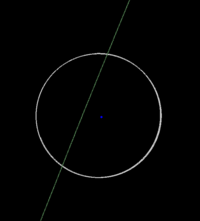Astronomy:(153814) 2001 WN5
| Discovery[1] | |
|---|---|
| Discovered by | LONEOS |
| Discovery site | Anderson Mesa Stn. |
| Discovery date | 20 November 2001 |
| Designations | |
| (153814) 2001 WN5 | |
| 2001 WN5 | |
| Minor planet category | |
| Orbital characteristics[1] | |
| Epoch 4 September 2017 (JD 2458000.5) | |
| Uncertainty parameter 0 | |
| Observation arc | 21.88 yr (7,990 days) |
| |{{{apsis}}}|helion}} | 2.5114 AU |
| |{{{apsis}}}|helion}} | 0.9125 AU |
| 1.7119 AU | |
| Eccentricity | 0.4670 |
| Orbital period | 2.24 yr (818 days) |
| Mean anomaly | 46.227° |
| Mean motion | 0° 26m 24s / day |
| Inclination | 1.9197° |
| Longitude of ascending node | 277.51° |
| 44.569° | |
| Earth MOID | 0.0015 AU (0.6 LD) |
| Physical characteristics | |
| Mean diameter | 0.932±0.011 km[2] |
| Geometric albedo | 0.097±0.016[2] |
| Absolute magnitude (H) | 18.3[1] |
(153814) 2001 WN5 is a sub-kilometer asteroid, classified as near-Earth object and potentially hazardous asteroid of the Apollo group.
| Date & Time | Approach to |
Nominal distance | uncertainty region (3-sigma) |
|---|---|---|---|
| 2028-Jun-26 05:23 | Earth | 248714 km | ± 25 km[3] |
| 2028-Jun-26 07:43 | Moon | 502854 km | ± 26 km |
Description
It was discovered by the Lowell Observatory Near-Earth-Object Search at Anderson Mesa Station on 20 November 2001,[4] The potentially hazardous asteroid was removed from the Sentry Risk Table on 30 January 2002.[5]
There are precovery images dating back to 10 February 1996.[1] The orbit is well determined with an observation arc of 14.9 years which includes two radar delay observations. It has an Uncertainty Parameter of 0.[1]
The asteroid will pass 248,700 km (0.647 LD) from the Earth on 26 June 2028.[1] During the close approach, the asteroid should peak at about apparent magnitude 6.7,[6] and will be visible in binoculars. It has an absolute magnitude (H) of 18.2.[1]
According to observations by the NEOWISE mission, the asteroid measures approximately 0.9 km in diameter and its surface has a rather low albedo of 0.097.[2]
References
- ↑ 1.0 1.1 1.2 1.3 1.4 1.5 1.6 1.7 1.8 "JPL Small-Body Database Browser: 153814 (2001 WN5)". Jet Propulsion Laboratory. https://ssd.jpl.nasa.gov/tools/sbdb_lookup.html#/?sstr=2153814&view=OPC. Retrieved 13 January 2018.
- ↑ 2.0 2.1 2.2 Mainzer, A.; Grav, T.; Bauer, J.; Masiero, J.; McMillan, R. S.; Cutri, R. M. et al. (December 2011). "NEOWISE Observations of Near-Earth Objects: Preliminary Results". The Astrophysical Journal 743 (2): 17. doi:10.1088/0004-637X/743/2/156. Bibcode: 2011ApJ...743..156M. http://adsabs.harvard.edu/cgi-bin/bib_query?bibcode=2011ApJ...743..156M. Retrieved 13 January 2018.
- ↑ "Horizons Batch for 2028-Jun-26 05:23 UT". JPL Horizons. https://ssd.jpl.nasa.gov/horizons_batch.cgi?batch=1&COMMAND=%27153814%27&START_TIME=%272028-Jun-26%2005:23%27&STOP_TIME=%272028-Jun-27%27&STEP_SIZE=%271+day%27&QUANTITIES=%2720,39%27. Retrieved 2021-01-24.
- ↑ "153814 (2001 WN5)". Minor Planet Center. https://www.minorplanetcenter.net/db_search/show_object?object_id=153814. Retrieved 13 January 2018.
- ↑ "Date/Time Removed". NASA/JPL Near-Earth Object Program Office. http://neo.jpl.nasa.gov/risk/removed.html. Retrieved 2011-10-16.
- ↑ "2001WN5 Ephemerides for 26 Jun 2028". NEODyS (Near Earth Objects – Dynamic Site). https://newton.spacedys.com/neodys/index.php?pc=1.1.3.1&n=153814&oc=500&y0=2028&m0=06&d0=25&h0=0&mi0=0&y1=2028&m1=06&d1=27&h1=0&mi1=0&ti=1.0&tiu=hours. Retrieved 2011-10-16.
External links
- Sormano Astronomical Observatory: Close encounter between Asteroid (153814) 2001 WN5 and Earth, diagrams and orbit evolution
- (153814) 2001 WN5 at NeoDyS-2, Near Earth Objects—Dynamic Site
- Ephemeris · Obs prediction · Orbital info · MOID · Proper elements · Obs info · Close · Physical info · NEOCC
- (153814) 2001 WN5 at ESA–space situational awareness
- (153814) 2001 WN5 at the JPL Small-Body Database
| Preceded by 367943 Duende (2012 DA14) |
Large NEO Earth close approach (inside the orbit of the Moon) 26 June 2028 |
Succeeded by 99942 Apophis |
 |


